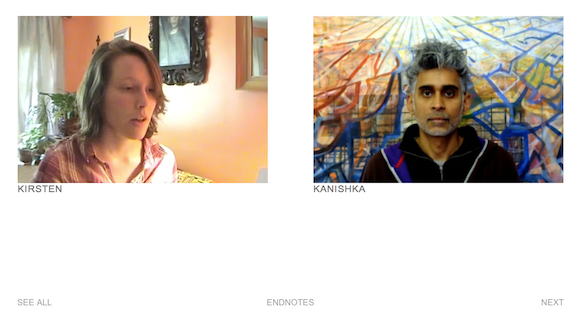
Laylah Ali, John Brown Song! (2013). Cropped screenshot of website with Quicktime videos.
Laylah Ali’s project, John Brown Song!, was launched in June as part of Dia Art Foundation’s artist web projects. It includes the videos of a number of people singing the song "John Brown’s Body," a Civil War–era marching song about a radical abolitionist who was executed in Virginia in 1859. The videos are arranged in twos, but a viewer could also choose to view all, in a grid of videos that can be played together, generating a multitude of voices, all singing different versions of the somewhat gruesome song ("John Brown's body lies a-moldering in the grave…")
Ali doesn’t give you much. A viewer is left to make sense of it alone—nine pages, each with two videos of different people singing, then an "endnotes" page which includes James Baldwin talking about the American dream coming at the expense of the African American, Whitney Houston and Johnny Cash singing the John Brown Song, a rap version thereof, as well as a series of 19th-century drawings of John Brown. Finally, if one clicks on "Thanks/Credits," one might find this line: "If you have arrived at this point and are still wondering 'Who was John Brown?' then please click here." I learned more about John Brown from this link than from the work itself.
Is a web project the best way to experience this archive that Ali builds? One would presume that another way of presenting these vignettes would be in an edited video or multi-channel installation, which would also generate a similar score of voices but would not leave the viewer with the same sense of assembling the story. And the somewhat vague tone of it (the introduction to the project tells very little of the backstory) induces the user to go to the natural surrounding of this project—Google, that is—to learn more, and more actively, than they could from any wall text in a museum.
Dia commissions very few of these web projects—only one or two a year—but it began doing them astonishingly early, in 1995, and has not missed a year since. The organization states that artist are chosen "for their interest in exploring the aesthetic and conceptual potentials of the medium, rather than their fluency or proficiency with technology." The result is that the Dia project is oftentimes the first web-based project these artists worked on. For some, it seems like a natural extension of their practice. But "natural" can be a little complex here, as in the case of Rosa Barba's 2008 web project Vertiginous Mapping. Barba's work generally considers the medium she uses quite intensely, mainly by focusing on the physical properties of said medium—usually 16mm film and projectors, in works that transform the film itself or its presentation in the space in a way that forces the viewer to think about the materiality of the medium rather than its illusion. For Dia, she created an archive of text and film that reads like a story. In a way, Vertiginous Mapping combines Barba's interest in film with the layered structure of the online project, veering closer to narrativity than most of her work in celluloid. Similarly, Francis Alÿs’s 1999 contribution The Thief (a screensaver that considers the futile role of the screensaver as a solely aesthetic tool, accompanied by a witty text laid in links providing insight into Alÿs’s thinking of the project, which includes conflating Windows95 with Alberti’s Window, the Renaissance-era system of understanding perspective in painting) examines a format that is new to the artist’s work in a manner that is consistent with his broader project of identifying small inconsistencies that society has grown used to and drawing our attention to them.
Amid the constant overhaul of museum websites to include research material, archival content, and web 2.0–like features, a number of art institutions have recently been rethinking their websites as sites for exhibition. What makes Dia's program particularly intriguing is the foundation's commitment to supporting new projects, and especially works by artists who aren't necessarily comfortable in the online space. Ali is a painter. Dia facilitated an opportunity for her to think about what an online project could mean in the context of her larger practice, opening up a new way to approach subjects she has dealt with in other media. Dia have considered the question, "What could the internet be for an art institution?" by thinking about what the internet could be for artists.
Dia’s mission is "to extend the boundaries of the traditional museum to respond to the needs of the generation of artists whose work matured and became prominent during the 1960s and 1970s ... to commission, support, and present site-specific long-term installations and single-artists exhibitions to the public." I wonder if we can think of the space of Dia’s web projects as similar to one of the projects the foundation maintains like Walter De Maria’s Lightning Field in New Mexico or Smithson’s Spiral Jetty in Salt Lake. Even if the web projects the foundation maintains may not live on in history to be as giant as the two land art examples cited, they do exemplify that any art institution’s mission statement should be read with new technologies in mind.

